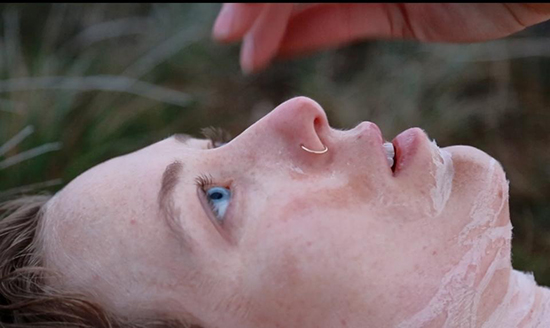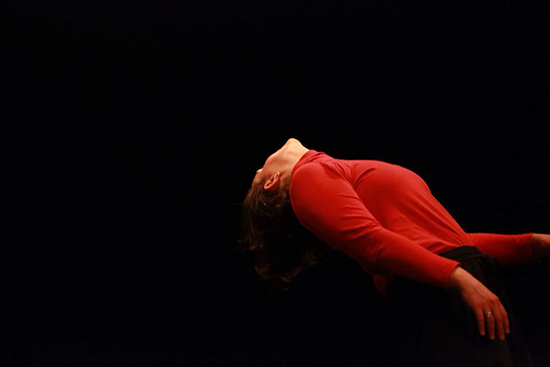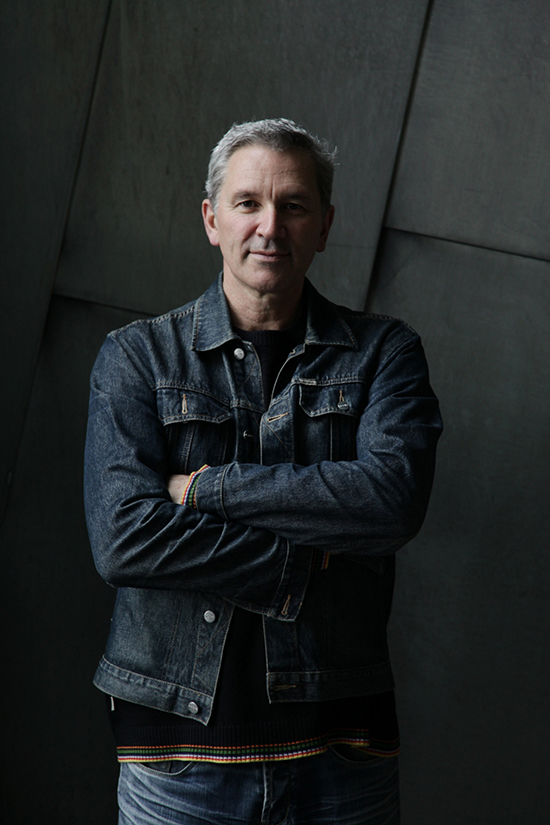Art, empathy and risk
Zsuzsi Soboslay: Strange Attractor: Make-Think-Speak

Loren Kronemyer, Strange Attractor
At the end of a two-week investigative process, Strange Attractor, a choreographic platform now in its fourth year in Canberra at Gorman Arts Centre, presented showings by eight choreographers gathered nationwide. On the eve of the 2016 federal election, this year’s mentor/facilitator David Pledger set the tone of provocations by insisting each artist address their role as an agent of political and social force who can make/think/speak in and to the world.
Pledger called in CSIRO ecologist Brian Walker and University of Canberra designer Susan Boden to cut edges into the frame of this dialogue from their respective disciplines. Boden discussed the relation between stability (of practice, of context) and moments of disturbance and unknowing. Walker talked about the difference between brittle, overstretched systems that will fail and resilient systems that can transform. Both prompted the artists to each consider and challenge their practice ecologies.
Alice Dixon felt provoked to “embrace mess, free radicals, not knowing.” Her performance involved a ladder, a screen, a captive tree, the sawing off of its limbs from astride the ladder and, once she was back on the floor, mischievous pliés and jetés. There were satisfying disjunctures in this work, hinting at a relation between human obsessions to cut things down—ecological disasters when nothing is left—and the fantasies people concoct to try to stabilise shifting ground. Dixon ended with a wink: her lightness of touch suggested it could all be performed again, differently.
Liz Lea showed an excerpt from her richly delicate film Red, which enters the territory of sickness, wounding and healing. Lea’s provocation became, “How much do I really want to share?”—which is also a question around our expectations of others’ empathy. Over two nights, she both danced in, to and out of a ‘show and tell’ model. One night we saw the film, the other night we did not—a rare opportunity for such a seasoned performer to experiment with incompleteness.

Ella Rose Trew, Strange Attractor
Shona Erskine choreographed to her research on 18th century ‘scarlet’ women, unjustly hanged or wrongly freed, depending on social status. Among dancer Ella Rose Trew’s nerve-electrified shakings were more literal enactions of being hung, shot or decapitated. She slid one leg in a deep curtsey: the woman as scapegoat for a culture that can’t accommodate her sexuality or mendacity. It is a bow the grace of which transcends prejudice and the finality of sentencing.
Erskine remained unresolved in her initial intention to include narrated text. Which of dance or narration better represents personal emotion versus social injustice? In the end, her choice for silence rather than text or constant musical overlay allowed for a finer interplay of ironies.
William McBride explored a fine calibration of shifting awarenesses in relation to his audience. His eyes and body rolled away from and then directly towards spectators’ bodies and fields of vision. He whispered an intimate exchange—does it matter no-one else heard?—as he rolled up into the stalls and between legs before hanging from the aircon duct, like a lost bat. Disappearing over the rails, he reappeared again, only to reverse the roll into blackout. He had worried into crevices, melted as into a stream: a survival instinct. There was much his beautiful work hinted at but did not fully reveal.
Daisy Sanders found herself questioning her complicity with social/political/environmental forces. Federal polling booths had shut one hour before her second night’s performance, providing a direct context for her questioning. She inhabited the Canberra Contemporary Arts Space foyer over 10 days as a quietly restrained yet occasionally volatile presence. Her work played with paper, balloting, voting, inscriptions—on walls—and boundaries between public and private life and emotions. The walls were both fragile and resilient—any moment’s marking or decision-making could also be its undoing as she occasionally unscrolled or shredded paper.
Loren Kronemyer created two short films. In one, in a low-angle shot, we see a woman through a window repeatedly leaping from her bed, grabbing a knife, heading to a door just out of frame. Frame cut: the motion is obsessive and paranoid, repeated again and again. We are on the outside, as if physically part of the deafening cicada chorus that constitutes the sound track. Are we animal, vegetable, mineral or human? Friend or foe?
Her second film shows close-ups of Kronemyer peeling skin from belly, ribs and face. The ’skin’ is a layer of glue, but by golly it’s convincing, like an animal shedding in the wild. In extreme close-up, she removes the ‘skin’ (contact lenses) of her eyes. Empathy sits in an uncertain state between self and other, discomfort and revulsion.
Alison Plevey gathered courage in her plan to start an Australian Dance Party, a performative arts advocacy group working towards a public launch. Her action to illustrate the word ‘artist’—upper torso forward, arms outstretched, a leg stretched behind—was both a joke on supplication, an awkward yeti in distress and a demand to be seen. Her work captured the tension between vulnerability and force that all the dancers feel. With Trew and Fyfe, she practised almost daemonically over the two weeks. “The Art of Conversation,” she realised, “needs practising.”

David Pledger
Mid-week, facilitator David Pledger had delivered a public “launch” of his projected role as Minister for Empathy. How can empathy survive and answer to ‘policy’? He seemed fighting-fit for both immediate successes and possible failures in that role, triggering a spirited discussion among the gathered audience.
Pledger asserted that “artists are the canaries in the coalmine of democracy” and therefore (presumably) necessary to the foundation and operations of any social organisation—otherwise who would be aware of the health or toxicity of a system? Somehow, in the scrum of this shared residency, Pledger’s positive demeanour overrode any ‘lamb to the slaughter’ connotations implicit in the canary metaphor.
The ‘last say’ in this event came from Matt Shilcock, in the venue’s central courtyard, dancing the intersection between everyone’s investigations as spectators moved from one presentation space to another. An almost selfless act of generosity—the still point of a seven–pointed star, performing a subtly reflective commentary that needed no words.
–
Strange Attractor 2016, Make-Think-Speak: artistic director, curator Adelina Larsson, facilitator, mentor, David Pledger, writer-in-residence Zsuzsi Soboslay, participants Liz Lea, Alison Plevey [ACT]; Shona Erskine, Loren Kronemyer, Daisy Sanders [WA]; Matt Shilcock [SA]; Alice Dixon, William McBride [VIC], additional dancers Ella-Rose Trew, Olivia Fyfe; David Pledger is running for office, June 22; supported by ArtsACT, Ainslie Arts Centre, Gorman Arts Centre, QL2 Dance, Canberra Contemporary Art Space; Gorman Arts Centre, Canberra, 19 June-3 July
RealTime issue #133 June-July 2016






